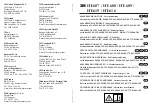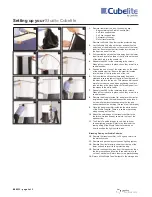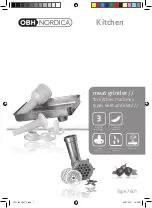
E3S-A
Safety Precautions
This product is not designed or rated for
ensuring safety of persons.
Do not use it for such purposes.
Do not use the product in atmospheres or environments that
exceed product ratings.
Mounting
Position of Optical Axis of Through-beam Model
Unlike conventional through-beam sensors, the E3S-A
Through-beam Photoelectric Sensor incorporates 2 lenses.
The lens actually in use is the one marked with an arrow
indicating the position of the optical axis. When using a Slit,
attach it to the lens marked with the arrow.
Tightening the Connector
Manually tighten the connector until the threads have
completely disappeared. If tightening is insufficient, the
degree of protection may not be maintained, or the connector
may become loose when it is subjected to vibration. Using
pliers to tighten the connector may damage it.
Use the E39-L60 Close Mounting Plate (provided) if the
Sensor is mounted using mounting brackets or if it is mounted
directly. (Refer to
Dimensions
.)
Mounting Bracket (Provided)
The direction of the optical axis coincides with the machine
axis of the E3S-A when the mounting screw is inserted into
the lock hole of the Mounting Bracket. If the mounting surface
and the screw hole are correctly aligned toward the sensing
object (or toward the Retroreflector for a Through-beam
Sensor), the mechanical axis and optical axis will be aligned
when the screw is inserted into the hole. Incident light will be
detected, and time-consuming adjustment will not be
necessary. (If, however, the mounting surface is not flat,
adjustment of the optical axis may still be required.)
Adjust the position of the Sensor so that incident light points
at the center. Make sure that the incident light is at a fixed
position.
The maximum tightening torque of the screw is 0.53 N
.
m max.
●
Adjustments
E39-S46 Through-beam Slits
(Accessory, order separately)
Use the rubber attachment with the metal cover if a slit width
of 2 mm is required. (A Slit is not required in this case.) Insert
the 0.5- or 1-mm Slit between the metal cover and rubber
attachment if a slit width of 0.5 or 1 mm is desired.
These Slits fit into the rubber attachment.
Apply the Slit to the lens of the Photoelectric Sensor marked
with an arrow indicating the position of the optical axis (apply
it to the bottom lens of Horizontal Sensors and the top lens of
Vertical Sensors).
WARNING
Precautions for Correct Use
Unused lens
Optical axis indicator arrow
Arrow indicating optical axis position
Lens actually in use (attach the Slit to this lens)
Position of Arrow Indicating Optical Axis
Model
Position of lens in use
E3S-A
(Vertical Sensors)
Top
E3S-A
(Horizontal
Sensors)
Bottom
Screw
Optical axis
Machine axis
Base of mounting
bracket
Bracket can move
in this direction
Optical axis lock hole (M3)
Arrow indicating
position of optical axis
2 mm
13.6 mm
11.1 mm
Metal cover
Slit (0.5 mm or 1 mm)
Rubber attachment
Indented portions
E3S-A
http://www.ia.omron.com/
10
(c)Copyright OMRON Corporation 2008 All Rights Reserved.
electronic components distributor











































